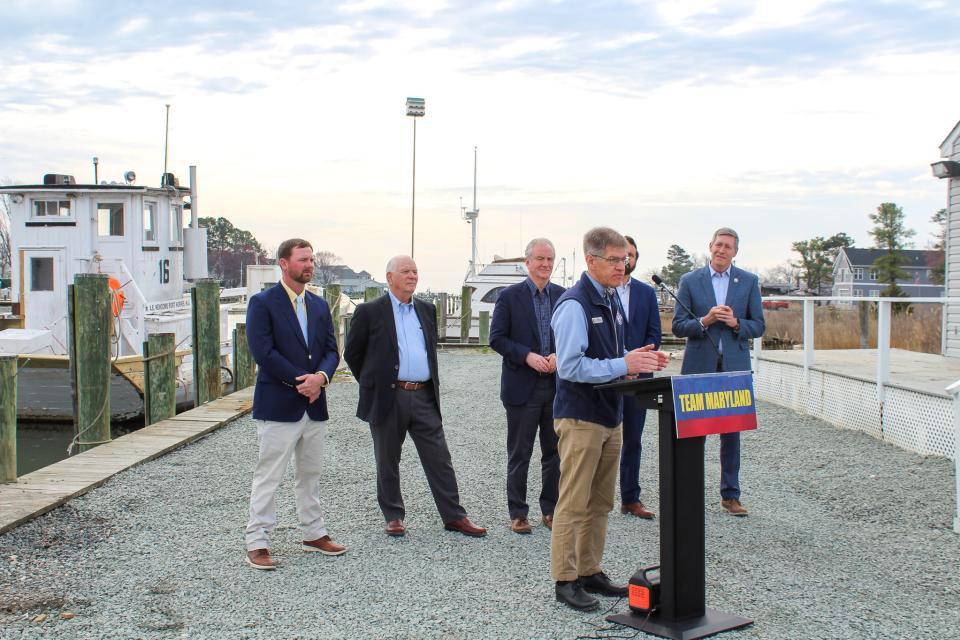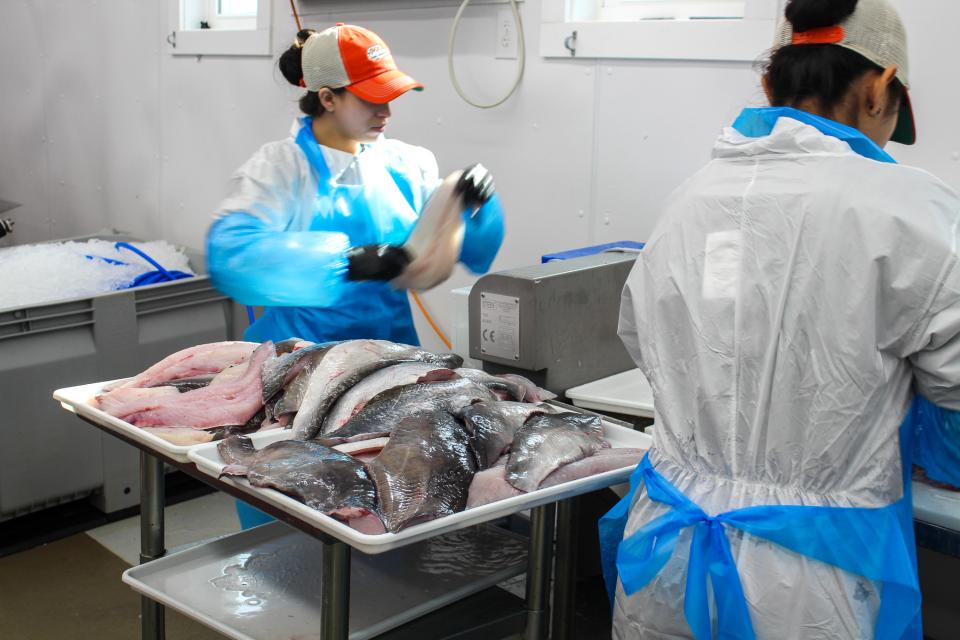U.S. Senators Visit Seafood Processing Business in Tilghman
03/15/2024
Category: Economic Development and Tourism County Council
Press release provided by Office of Chris Van Hollen. Original publish can be found here: Van Hollen, Cardin Visit Seafood Processing Business, Highlight Efforts to Accelerate Blue Catfish Processing | U.S. Senator Chris Van Hollen of Maryland (senate.gov)
Senators Van Hollen and Cardin, Congressman Harris secured funding in recently enacted FY24 appropriations package.
Today, U.S. Senators Chris Van Hollen and Ben Cardin visited Tilghman Island Seafood in Talbot County – the only USDA-certified blue catfish processing facility on Maryland’s Eastern Shore – to highlight federal resources that they fought to pass in the recently enacted fiscal year 2024 agriculture appropriations bill to support catfish processing and protect other species in the Bay. The Senators were joined by Maryland Secretary of Natural Resources Joshua Kurtz, Maryland Agriculture Secretary Kevin Atticks, and local officials.
Blue catfish have severely disrupted the balance of the Bay’s ecosystems over the years. Ever since they were introduced for sportfishing in Virginia in the 1970s, their population has exploded due to their tolerance of a wide range of environmental conditions and lack of natural predators. They also have endless appetites for the wide variety of aquatic species native to the Bay, including rockfish, shad, and blue crabs. To address these issues, the Senators and Congressman Andy Harris (R-Md.) worked to fund key programs and include other legislative provisions in this year’s agriculture funding bill intended to increase processing capacity and support the study of new strategies to control the blue catfish population.
“Blue catfish pose a growing environmental and economic threat to our treasured Chesapeake Bay as they grow in number and prey on our iconic blue crabs and rockfish. Fortunately, blue catfish are also delicious, meaning this is a problem we can literally eat our way out of. In order to facilitate getting more blue catfish on the menu, Senator Cardin and Congressman Harris and I have secured resources to boost catfish processing and spur market demand, as we continue to explore additional ways to control their population growth,” said Senator Van Hollen.
“Blue catfish present a challenge for the Bay. Their rapid expansion and population growth is profoundly affecting the Bay’s ecosystem. The appropriations bill Congress just passed includes $3 million to help places like Tilghman Island Seafood support greater processing capacity of invasive wild-caught catfish. It also provides $500,000 to support research and population monitoring to fill critical gaps in our understanding of how blue catfish are impacting the Bay,” said Senator Cardin. “Invasive species management is a complex problem that will require multifaceted solutions. This could only be done with government and private sector working together to figure out a way to manage the population.”
“Invasive blue catfish have spread rapidly throughout Maryland in recent years and multiple studies have shown these predators are eating significant amounts of blue crabs, white perch, and other commercially and culturally important species,” said Maryland Department of Natural Resources Secretary Josh Kurtz. “We’re encouraging commercial fishermen and other anglers to harvest blue catfish to reduce the ecological harm caused by the fish. This federal funding will help reduce blue catfish processing bottlenecks and in turn bring more wild-caught blue catfish to grocery stores, restaurants, and dinner tables.”
“Agriculture is an incredible asset to Maryland’s rural economy and the path forward for fortifying our food system. The industry is a steadfast partner in Chesapeake Bay restoration, ensuring that we are supporting the ecosystem while feeding Marylanders,” said Maryland Department of Agriculture Secretary Kevin Atticks.
“We are very proud of the work that Nick Hargrove has done with Tilghman Island and Wittman Wharf Seafood with regards to blue catfish. He is not only helping our local economy, he is truly making a difference fighting this invasive species as the Eastern Shore’s only blue catfish processor. We are grateful for the investment of time and federal funds to supporting his business. Nick has the full support of Talbot County as well as our watermen and seafood businesses,” said Talbot County Manager Clay Stamp.
“As the only USDA-certified blue catfish facility on the Shore, we process 20,000 pounds of blue catfish every day. This business is not only supporting watermens’ livelihoods, it is also proof that we can build an economy around a challenge that we all need to work together to address for the Bay we love. This is still just the beginning – I’m grateful for the work of our federal delegation for helping to create a more stable market and stronger industry for blue catfish,” said Nick Hargrove, owner of Tilghman Island Seafood.
Measures in the FY24 agriculture appropriations bill to address blue catfish in the Bay
- $3 million for the USDA Rural Development Meat and Poultry Processing Expansion Program (MPPEP): The lawmakers created the MPPEP through the American Rescue Plan Act to help small food processors expand their capacity and address COVID-19 processing challenges and processing monopolies that increased the cost of getting products to market. The FY24 agriculture appropriations bills provides $3 million for the program and includes report language encouraging the U.S. Department of Agriculture (USDA) to prioritize proposals that support the processing of invasive wild-caught catfish.
- Up to $1 million available for the USDA Food Safety and Inspection Service (FSIS): Since 2017, all catfish have been under the regulatory jurisdiction of USDA, rather than under the Food and Drug Administration (FDA) like all other fish. The USDA inspection process has proven more burdensome when compared to the FDA, as FSIS inspection personnel must be present at least once per shift at catfish processors. This poses challenges since unlike meat processing – which can be done at set times – catfish processing can vary based on timing of the catch. To help address this issue, the lawmakers secured $1 million in funding to offset the costs of inspectors’ overtime pay when inspections are required outside of traditional daytime working hours.
- Including wild-caught catfish under USDA’s Agricultural Marketing Service, Section 32: Section 32 allows the USDA Agricultural Marketing Service (AMS) to make commodity purchases and other disaster assistance, which are diverted to the National School Lunch Program and other domestic food assistance programs. Including wild-caught catfish under Section 32 is intended to help remove surplus from the market and spur more demand.
- $500,000 for Invasive Catfish Control through USDA’s Animal and Plant Health Inspection Service (APHIS): Senators Cardin and Van Hollen successfully included this funding as an amendment to the FY24 agriculture funding bill in order to equip the Maryland Department of Natural Resources to improve our understanding of blue catfish. Funding could be used to monitor and understand where catfish are in the Bay, their seasonal movement, and where they spawn; further study their diet patterns; develop early warning systems to facilitate early removal from new tributaries; and test removal methods.
Page last modified Friday, May 3, 2024 11:38:20 AM




